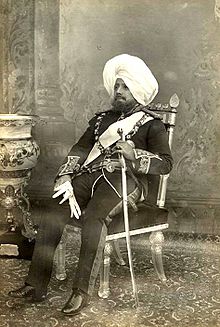Partab Singh of Kashmir
| Pratap Singh of Jammu and Kashmir | |
|---|---|
| Maharaja of Jammu and Kashmir | |

Pratap Singh of Jammu and Kashmir
|
|
| Maharaja of Jammu and Kashmir | |
| Reign | 12 September 1885 – 23 September 1925 |
| Predecessor | Ranbir Singh |
| Successor | Hari Singh |
| Born | 18 July 1848 Jammu, Kashmir and Jammu, British Raj |
| Died | 23 September 1925 (aged 77) |
| House | Royal House of Jammu and Kashmir |
Maharaja Sir Pratap Singh GCSI GCIE GBE (18 July 1848 – 23 September 1925) was the Maharaja of Jammu and Kashmir, and head of the Jamwal Rajput clan.
Some elements in the British Empire made an attempt to implicate the Dogra Maharaja in a conspiracy case involving the Russian Empire. At the end a ruling council was forced on Jammu and Kashmir, which included a British agent and the Maharaja's brother Amar Singh.
Amar Singh's son Hari Singh succeeded his uncle as the Maharaja in 1925.
Before Pratap Singh's accession, the British Government was represented in Kashmir by an Officer-on-Special Duty who had only limited functions to perform. The Government of India had made many attempts at the time of Ranbir Singh to raise the status of the Officer to that of a full-fledged Political Resident. The Maharaja had, however, successfully resisted these. But now taking advantage of the fresh succession they were able to post a Political Resident in Jammu and Kashmir.
Within the British Empire, Jammu and Kashmir was a salute state. In 1921, the Maharaja of Jammu and Kashmir was upgraded to a permanent and hereditary 21-gun salute (from a 19-gun salute). Pratap Singh was granted the increased ranks as a result of the meritorious services of the Dogra soldiers in the First World War.
During the time of Pratap Singh, the first major step of improvement was taken in 1889 when the Jhelum Valley Cart Road, "the most wonderful mountain road in the world", from Kohala to Baramulla was completed. It was extended to Srinagar in 1897. In 1922, another great highway, the Banihal Cart Road, which connected Srinagar, the summer capital, with Jammu,the winter capital of the state was thrown open to the public. Besides these, many feeder roads in the state including those connecting Srinagar with Gilgit and Leh were also constructed. The impact of these roads on the life of the people of Jammu and Kashmir may be judged from the fact that before Pratap Singh, there was not a single wheeled conveyance, including even a hand-cart. By the time his reign came to a close, motor cars became the principal means of conveyance .
...
Wikipedia
